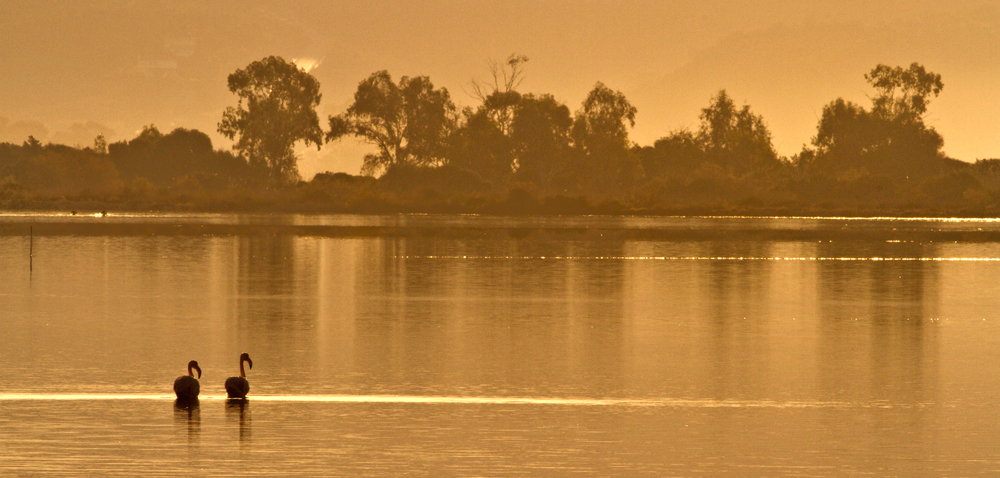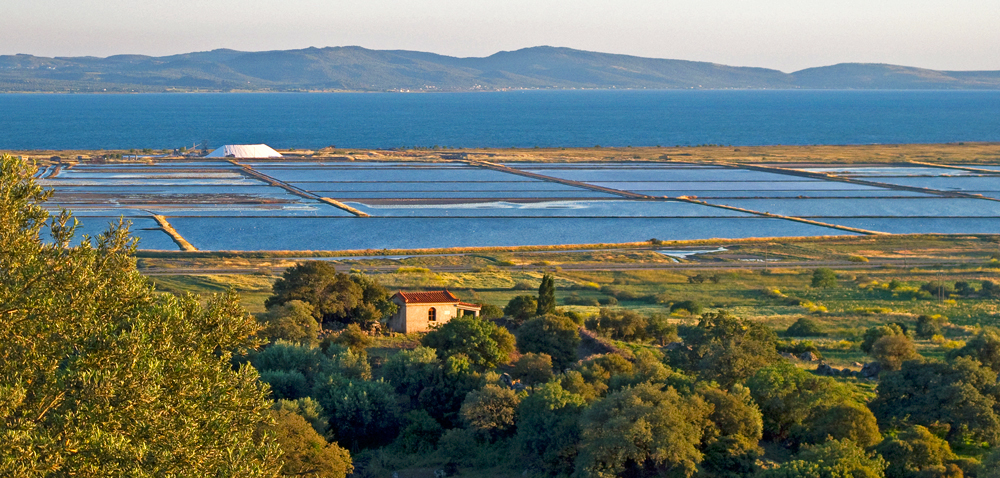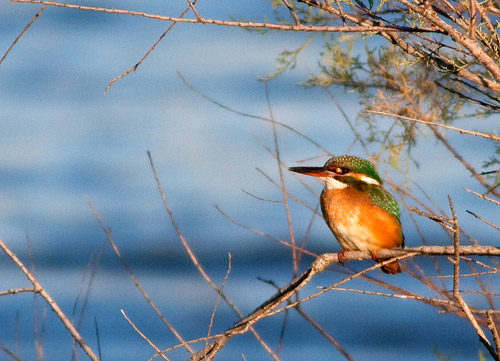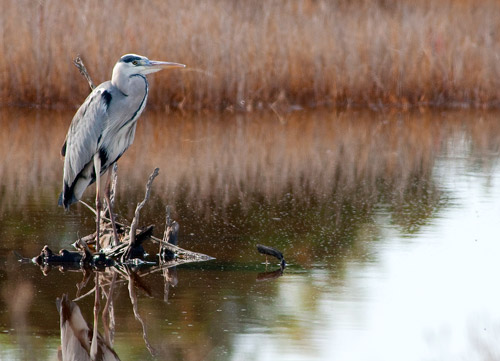Wetlands
Gialova

Favored by the coastal morphology, the location and the rich subsoil, Gialova lagoon is a habitat that magnetizes dozens of rare species of fauna. Gialova is one of the southernmost large wetlands in Europe and one of the most important stations for migratory birds in Greece. Other names of the lagoon are Divari and Daliani. It is located on the southwestern tip of the Peloponnese, on Messinia perfecture and covers an area of 620 acres. Together with the surrounding area that includes crops, golden beaches and hills, it spreads on an area of about 40 sq.kilometer. At west it is separated from the Ionian sea by Koryphasio cape on top of which stands the Palaiokastro castle. To the east and north is bordered by crops and low hills. To the south it is protected from Navarino bay by a narrow sandbank 3.5 km long and 130 meters wide. At north lies the famous sandy beach of Voidokilia, while at its southwest end is separated from the island of Sfaktiria by a narrow channel (500 meters long and 120 meters wide). Gialova is a brackish, shallow lagoon, with a maximum depth of 1,5 meters, receiving the waters of Typhlomytis spring and Xerolagado stream. Many different habitats surround it, such as sand dunes, salt marshes, reed beds, small forests, vertical rocks, sandy beaches, water channels and shrubland. Gialova combines ecotourism with some important historical sights, such as the cave of Nestor in which, according to Greek mythology, god Hermes hid the sacred cows that stole from god Apollo, the island of Sfaktiria and Chelonisi with the monuments of the Russian and English soldiers that fell on the naval battle of Navarino (October 1827) and Niokastro castle of Pylos. Unfortunately, the ecosystem has been greatly altered compared to a few decades earlier, as it has been subjected to intense pressures such as desiccation efforts, changes in the aquifer, pollution from olive oil processing waste, marine accidents of large tankers, illegal hunting and mass tourism. However, and especially during periods of bird migrations, Gialova still attracts hundreds of naturalists and explorers every year.
The vegetation of the area consists of the characteristic plants of the coastal wetlands, while a little higher begin maquis shrubland and pine forests interrupted by olive trees. In the dunes and the big sand strip lie forests with tamarisks, phoenicean junipers, lentiscs and eucalypts. Among the endemic and rare plants of the surrounding area stand out Fritillaria conica, Limonium pylium, Arenaria peloponnesiaca, Stachys canescens and Allium circinnatum subsp. peloponnesiacum. Other interesting plants are Iris pseudacorus, Iris unguicularis subsp. carica, Iris tuberosa, Colchicum parlatoris, Ranunculus millii, Mandragora officinarum, Galanthus reginae-olgae subsp. reginae-olgae, Crocus boryi, Cyclamen rhodium subsp. peloponnesiacum, Pancratium maritimum, Veronica glauca subsp. peloponnesiaca, Anchusella variegata, Dianthus fruticosus subsp. occidentalis, Allium callimischon subsp. callimischon, Narcissus tazetta subsp. tazetta, Narcissus obsoletus, Prospero autumnale, Anthemis arvensis subsp. cyllenea, Crepis neglecta subsp. graeca, Petrorhagia graminea, Scutellaria rupestris subsp. parnassica, Sedum eriocarpum subsp. eriocarpum, Beta vulgaris subsp. adanensis and Aetheorhiza bulbosa subsp. microcephala. Orchids in the region include species such as Himantoglossum robertianum, Neotinea lactea, Anacamptis laxiflora, Anacamptis papilionacea, Spiranthes spiralis, Serapias orientalis, Serapias parviflora, Serapias bergonii, Ophrys ferrum-equinum, Ophrys argolica, Ophrys spruneri, Ophrys herae, Ophrys speculum, Ophrys tenthredinifera, Ophrys lutea, Ophrys cornuta, Ophrys mammosa and Ophrys leucadica. The bottom of the lagoon is covered by large meadows of the seagrass Cymodocea nodosa.
Gialova’s importance to avifauna is enormous as it is the closest major wetland to Africa, thus serving as an important resting, feeding and breeding station for dozens of species. About 275 species of birds have been observed in Gialova. Especially in winter, large numbers of birds arrive here, such as little egrets, great egrets, greater flamingos and cormorants. Many species of ducks find shelter here, such as shelducks, ferruginous ducks, mallards, pintails, teals, shovelers, widgeons, garganeys and common pochards. Among predators, the presence of ospreys in winter stands out. Other species that occur in the area are lesser spotted eagles, spotted eagles, short-toed eagles, booted eagles, marsh harriers, hen harriers, honey buzzards, common buzzards, peregrine falcons, Eleonora’s falcons, sparrowhawks, lesser kestrels, kestrels and red-footed falcons. The owls of Gialova include eagle owls, long-eared owls, tawny owls, barn owls, little owls, scops owls and nightjars. Small flocks of cranes are occasionally stationed in the area. Almost all wading species of Greece pass through Gialova during their migratory journey with most important being black-winged stilts, redshanks, kentish plovers, marsh sandpipers, wood sandpipers and great crested grebes. Rare and interesting species observed in the area are black-throated divers, dotterels, bar-tailed godwits, lapwings, collared pratincoles, great snipes, rufous bush robins, wrynecks, bitterns, red-crested pochards, red-breasted mergansers, spoonbills and black storks. The avifauna is supplemented with species such as quails, water rails, avocets, slender-billed gulls, gull-billed terns, sandwich terns, whiskered terns, turtle doves, cuckoos, swifts, alpine swifts, hoopoes, kingfishers, bee-eaters, skylarks, woodlarks, crested larks, short-toed larks, crag martins, sand martins, house martins, swallows, red-rumped swallows, meadow pipits, water pipits, wrens, nightingales, black redstarts, stonechats, whinchats, blue rock thrushes, song thrushes, fantail warblers, Cetti’s warblers, moustached warblers, sedge warblers, great reed warblers, reed warblers, olive-tree warblers, olivaceous warblers, blackcaps, subalpine warblers, sardinian warblers, semicollared flycatchers, bearded tits, penduline tits, blue tits, great tits, long-tailed tits, rock nuthatches, red-backed shrikes, woodchat shrikes, starlings, jays, jackdaws, greenfinches, goldfinches, linnets, corn buntings, cirl buntings, black-headed buntings and reed buntings.
Of the amphibians here live common toads, green toads, tree frogs, balkan frogs and agile frogs. Particularly important is the herpetofauna of Gialova in which the presence of the African chameleon stands out, while loggerhead turtles are common in the bay of Navarino. Other reptiles in the area are balkan pond turtles, pond turtles, Hermann’s tortoises, marginated tortoises, Kotschy’s geckos, Mediterranean house geckos, greek algyroidess, balkan green lizards, Crimean wall lizards, Peloponnese wall lizards, snake-eyed skinks, limbless skinks, glass lizards, balkan whip snakes, Dahl’s whip snakes, cat snakes, leopard snakes, grass snakes, dice snakes, levant montpellier snakes and nose-horned vipers. Of the mammals stands out the return of the golden jackal in the surrounding hills. The presence of the formerly abounded otter is speculated. Other mammals are foxes, beech martens, weasels, badgers, hedgehogs, lesser white-toothed shrews and twelve species of bats. On the rich bottom of the lagoon are found about 85 species of invertebrates, 16 species of fish and more than 85 species of planktonic organisms. In the fresh waters around the lagoon, 6 species of fish have been recorded, most important being the endemic Spartian minnowroach (Tropidophoxinellus spartiaticus), the Epiros riffle dace (Telestes pleurobipunctatus) and the Peloponnese barbel (Barbus peloponnesius).
Πως θα πάτε
Gialova is about 300 km from Athens. Follow the National Road from Athens to Kalamata and just before you arrive turn for Pylos. A few kilometers before Pylos turn right towards Gialova. You can choose for your return the beautiful route that heads south to Methoni and Koroni, making the circle of the western foot of the Peloponnese. Gialova is ideal for bike tours.Εμφάνιση στο χάρτη
click to see the place on the map(Latitude: 36.96024849202026, Longitude:21.67387302372261)
Social Networks
Also Read

Kolovrechtis
A small wetland of Evia that, despite the constant pressures, still attracts dozens of species of birdlife, especially during migrations.

Kalloni saltpans
The largest wetland of Lesvos island and one of the most important stations for many wading and aquatic birds in the migratory route of the eastern Aegean.













